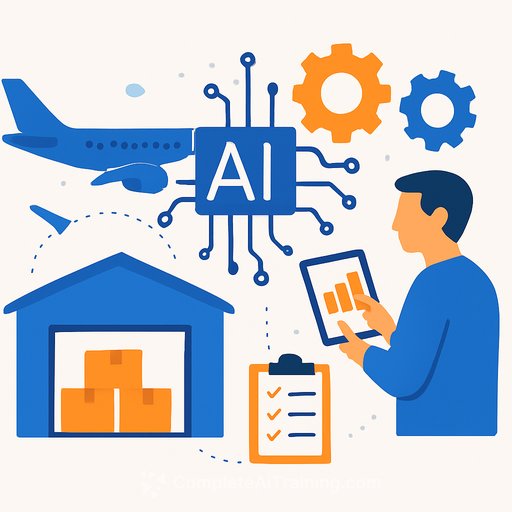AI Expansion Is Here: What Operations Leaders Need to Plan For Now
AI demand is spiking, and a major tech player is expanding to meet it. The move centers on infrastructure and strategic partnerships to make AI deployment smoother for businesses and consumers.
For operations teams, this isn't a headline. It's a signal. Capacity, suppliers, skills, and spend will all need a reset.
What's Driving the Expansion?
Global demand for AI solutions is up across healthcare, finance, and beyond. New applications need data pipelines, model serving, and scalable compute-fast.
The company has seen a sharp rise in customer interest and is building the support systems required to keep innovation and efficiency moving.
How This Shifts the Market
Expanded capabilities will likely set higher expectations for delivery speed, uptime, and model performance. Competitors will feel pressure to lift their standards.
The CEO said, "Our focus is on providing next-generation AI solutions to meet the evolving needs of our clients." That frames the goal clearly: better tech and a better user experience.
What Operations Teams Should Do Now
- Reforecast capacity: compute, storage, networking, and budget. Treat AI as a distinct workload in your planning.
- Set clear SLAs for AI services: latency, uptime, drift response, and incident MTTD/MTTR.
- Tighten vendor strategy: multi-cloud, GPU/accelerator supply, and exit plans to reduce lock-in.
- Stand up a data reliability layer: quality checks, lineage, and access controls to keep models fed with clean data.
- Launch a structured upskilling path for ops, data, and product teams to use and support AI safely.
Infrastructure And Capacity Planning
- Segment workloads: training vs. inference vs. analytics. Each has different cost and latency profiles.
- Adopt autoscaling for inference; queue and schedule training. Prioritize GPU utilization and job orchestration.
- Add resilience: multi-zone deployment, failover for model endpoints, and dependency maps for critical services.
- Plan for data growth: feature stores, vector databases, and secure retention policies.
- Use FinOps: track cost per model, per query, and per business unit. Tie spend to value, not hype.
Vendors, Partnerships, And Supply
- Pre-negotiate capacity bursts and SLAs for accelerators. Include lead times and substitution clauses.
- Pilot with two providers where possible. Keep models portable via open formats and standard tooling.
- Leverage partnerships with universities and research groups for talent pipelines and joint projects.
Talent, Training, And Org Design
Educational collaboration is picking up to meet demand for skilled professionals. This is your cue to formalize job roles and training paths.
- Define core roles: MLOps, data reliability engineering, AI product ops, prompt engineering, and model risk.
- Build enablement: office-hours, internal playbooks, and a service catalog for approved AI tools.
- Upskill your team with role-based learning paths. See curated options by job function at Complete AI Training.
Risk, Governance, And Compliance
- Establish an AI review process: data use, model bias checks, evaluation criteria, and rollout gates.
- Adopt a known framework for risk management, such as the NIST AI Risk Management Framework.
- Map regulations by region and industry. Log model lineage, training data sources, and evaluation reports.
- Create a model incident workflow: detection of drift, rollback steps, and customer comms.
KPIs To Track
- Latency and uptime for AI endpoints
- Model accuracy and drift rate by use case
- Cost per inference and per model lifecycle
- Time-to-deploy (from idea to production)
- User adoption and task completion improvements
- Compliance audit pass rate and incident count
90-Day Action Plan
- Days 0-30: Inventory AI use cases, data sources, and model endpoints. Set guardrails, SLAs, and a basic review board. Lock in near-term compute supply.
- Days 31-60: Stand up MLOps pipelines, feature store, and monitoring. Pilot multi-cloud or multi-vendor strategy. Launch targeted training for ops and product teams. Start cost reporting.
- Days 61-90: Formalize governance workflows, risk registers, and incident runbooks. Optimize spend. Scale the service catalog and internal support tiers.
Industry Impact And Workforce Effects
As capacity expands, expect faster releases, higher expectations on reliability, and more sophisticated tools in market. That means higher productivity-if teams can keep up.
Public reaction is mixed, and that's fair. Enhanced AI can streamline processes, but it also demands new skills and rethinking job design. A company spokesperson said, "Our expansion is built to foster innovation and drive economic growth." The practical next step is structured reskilling and clear career paths, supported by credible certifications like those at Complete AI Training.
Bottom Line
This expansion signals a new standard for how AI gets built, delivered, and supported. Infrastructure, partnerships, and education are the levers.
For operations leaders, the edge goes to teams that can plan capacity, enforce guardrails, control cost, and upskill-before demand hits their queue.
Your membership also unlocks:






